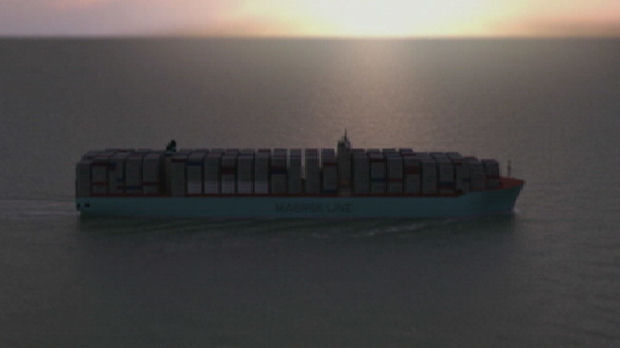Deal for biggest ever cargo ships sets sail
A deal between Danish shipping giant Maersk and Korean Daewoo Engineering will see the construction of the biggest, most efficient cargo ships ever made, as Tom Clarke writes.

They will make a big impact on the cargo industry. They can carry 16 per cent more cargo than the current record-holder and use 50 per cent less fuel than the industry average for each container shipped from Europe to Asia. And they are vast: Four football pitches could lie end to end on the deck. Each can carry 18,000 30-tonne shipping containers.
But they’re not technological marvels. They save fuel by having smaller engines and steaming more slowly. A TV set will take 3 days longer to get from China to London. But a slow ship can be built wider and flatter, meaning it can carry more containers.
Four football pitches could lie end to end on the deck.
Maersk are banking on these two factors making the new “Triple-E Class” more competitive. According to the press release, the “Es” stand for economies of scale, energy efficiency and environmental performance.
“By making a bigger ship we achieve all of these three fundamentals,” Eivind Kolding, CEO of Maersk Line told me.
The design is born as much out of the economic downturn as a desire among shipping firms to go green. The financial crisis hammered the industry. Many container ships are currently laid-up near Asian ports waiting for the economy to recover. Many big ship builders are trying to stay competitive by building new ships that can shift more containers with less fuel to keep costs down.
- Chapters
- descriptions off, selected
- subtitles off, selected
- captions settings, opens captions settings dialog
- captions off, selected
This is a modal window.
This is a modal window. This modal can be closed by pressing the Escape key or activating the close button.
‘Big, slow ships’
“The future is big, slow ships,” said Tristan Smith who studies the shipping industry at University College London.
“It’s a slightly regressive mantra because there are new technologies out there and perhaps more inventive ways to achieve a similar sustainability increase.”
But in the short term Maersk are gambling on it for a big part of the business: the Asia to Europe route which the Triple-E class will ply.
And it’s a big bet. The contract signed today is for ten ships – but with an option for ten more. The entire deal would total $6bn, making it the largest shipyard contract ever signed.
“Consumers are still spending more, outsourcing is still taking place so there will be a need for those ships,” said Mr Kolding.
“And if we at the same time make them very competitive and very environmentally friendly those are exactly the ships that will be in demand.”
A major shipping contract is a good barometer for the global economy – the industry at least seems to think trade between Asia and Europe will remain strong. However the European economy won’t benefit as much as Asia from the deal. All the jobs to build the new ships are in Korea and the vast majority of high value goods the ships will carry will be made in Asia to be sold here.